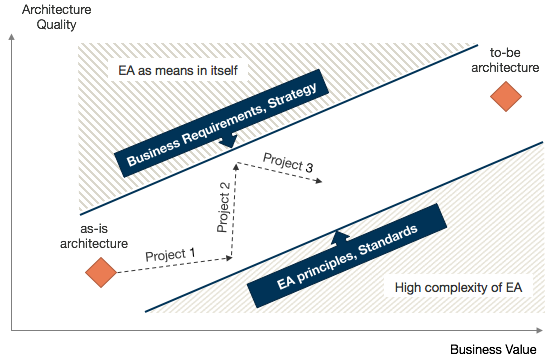The managed evolution approach is an iterative, controlled and continuous approach for EA development. The approach ensures that each transformational project influences the business value and the EA quality positively.
Foundations of the Managed Evolution Approach
The basic idea of the managed evolution approach is visualized in Figure 1 [Fuh13a]. The starting point of the approach is the knowledge of the as-is enterprise architecture as well as the to-be state of the architecture. These two states are located in a diagram where the x-axis represents the enterprise architectures contribution to the business value and the y-axis represents its level of architecture quality. Boundaries are applied creating a corridor which connects the as-is with the to-be architecture. On the one hand, the upper boundary is supposed to restrict states where the quality of the enterprise architecture is high but it doesn’t support the enterprises’ strategy or fulfill the business requirements, making it a means in itself. On the other hand, the lower boundary prevents states with high business functionality, but also high complexity of the enterprise architecture, rendering the enterprise architecture inflexible and difficult to manage. This lower boundary is implemented using IT principles and IT standards [Buc10a]. The resulting corridor constitutes the space of all allowed EA states of an enterprise architecture [MWF08].

Figure 1: The Managed Evolution Approach
Transformation projects change the business value and the quality of the architecture and therefore also its positioning within the diagram. It is now the enterprise architects’ task to ensure that only those transformation projects are chosen, that move the state of the enterprise architecture towards the to-be architecture and which lay within the evolutionary corridor [Fuh13a]. This way, each project contributes to the business value and the quality of enterprises architecture. The to-be architecture is a theoretical optimum, which can never be reached and which also changes over time [Fuh13a]. This leads to a never ending, iterative transformation process of the enterprise architecture [Fuh13a].
Advantages of the managed evolution approach are that the current architecture is seen as a valuable asset. Business value and quality of an enterprise architecture are improved continuously through transformational projects while preventing the erosion of the existing enterprise architec- ture [Fuh13a]. This way, a controlled development of the as-is enterprise architecture towards the to-be state is enabled.
Sources:
|
[Fuh13a] |
K. Fuhrer. “Architekturmanagement: Migrationsschritte zur Servicelandschaft, SOA-Transformation.” In: Business Technology (bt) Magazin 1 (2013). |
|
[Buc10a] |
S. Buckl. “A Conceptual Framework for Enterprise Architecture Design.” In: Trends in Enterprise Architecture Research - 5th International Workshop, TEAR 2010. Vol. 70. Lecture Notes in Business Information Processing (LNBIP). Delft: Springer, 2010, pp. 44–56. |
|
[MWF08] |
S. Murer, C. Worms, and F. J. Furrer. “Managed Evolution.” In: Informatik-Spektrum 31.6 (2008). |